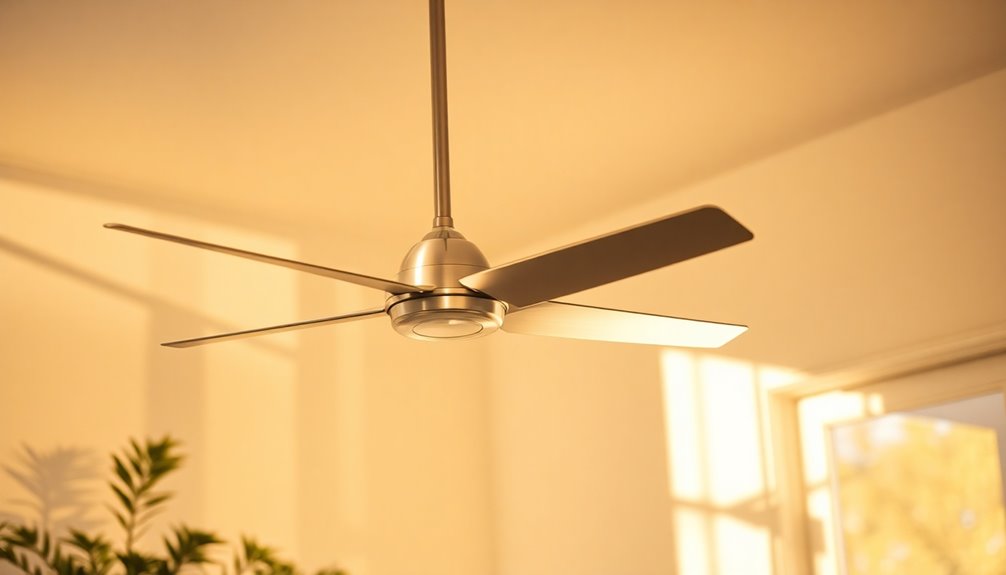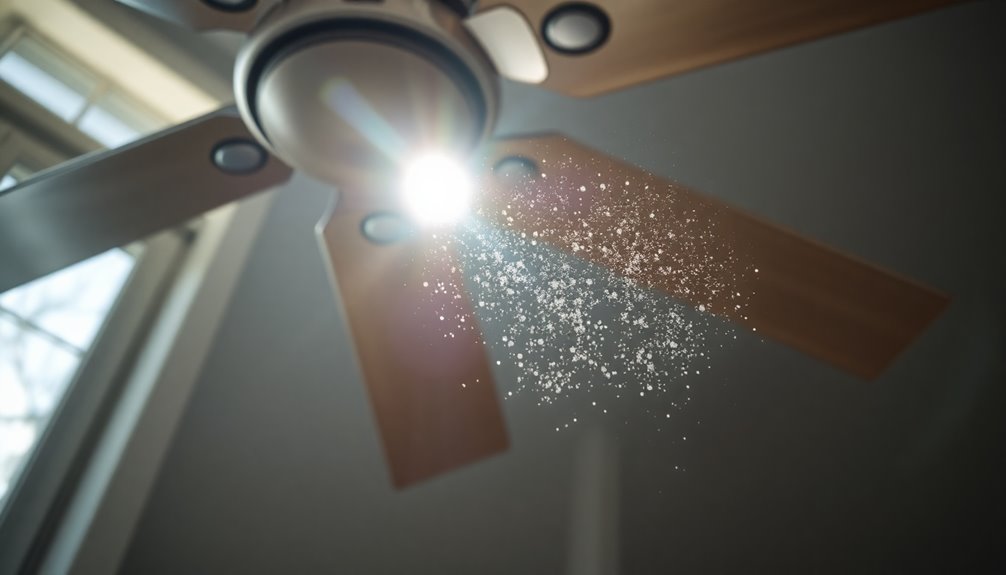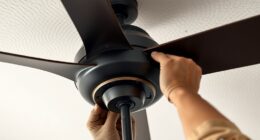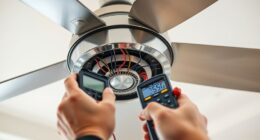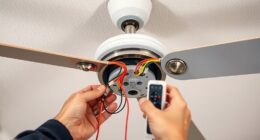In the summer, your ceiling fan should turn counterclockwise. This rotation creates a cooling downdraft that enhances airflow, making your space feel cooler. With the fan running this way, you can often raise your thermostat settings by about 4 degrees without sacrificing comfort. This can lead to energy savings of up to 30% on your cooling costs. Remember to check the fan's direction by standing directly under it to feel the airflow. If you're curious about optimizing your ceiling fan use throughout the year, there's more to explore on this topic.
Key Takeaways
- In summer, ceiling fans should rotate counterclockwise to create a cooling downdraft and enhance airflow.
- This rotation allows you to raise thermostat settings by about 4 degrees without discomfort.
- Counterclockwise rotation can reduce air conditioning reliance by up to 30%, leading to energy savings.
- To confirm the direction, stand under the fan and feel for a cool breeze.
- Regularly adjust the fan's direction seasonally for optimal comfort and efficiency.
Importance of Ceiling Fan Direction

The direction of your ceiling fan plays an essential role in maintaining your home's comfort and managing energy costs.
When you set your ceiling fan to spin counterclockwise during the summer, it creates a cooling downdraft that enhances airflow. This not only helps keep you comfortable but also allows you to raise your thermostat settings by about 4 degrees without feeling warm.
By maximizing the wind chill effect, you can enjoy a cooler environment while saving on air conditioning costs.
Proper ceiling fan direction is vital; if it's not set correctly, you might experience inadequate airflow, leading to discomfort and higher energy bills.
Running your ceiling fan counterclockwise can reduce your reliance on air conditioning by up to 30%, making it a smart choice for energy efficiency. Additionally, combining ceiling fans with energy-efficient heat pumps can further enhance your home's climate control while reducing overall energy consumption.
Summer Ceiling Fan Settings

Adjusting your ceiling fan settings for summer can greatly enhance your comfort while keeping energy costs in check.
To optimize your cooling, make sure your ceiling fan blades are set to turn counterclockwise. This direction creates a rejuvenating downdraft that pushes cool air downward, giving you that desirable wind chill effect. You'll feel cooler without the need to lower your air conditioning, allowing you to raise your thermostat setting by about 4 degrees.
Standing directly under the fan is the best way to confirm its counterclockwise movement. You'll notice the airflow rushing toward you, which is essential for achieving maximum cooling. Additionally, using a ceiling fan can lead to lower energy bills due to its ability to enhance airflow, reducing reliance on air conditioning.
Changing Fan Direction

To keep your space cool during summer, you need to change the direction of your ceiling fan to counterclockwise.
This adjustment helps create a revitalizing breeze that can lower the temperature in your room.
Make sure to turn the fan off before making any changes for safety and efficiency.
Fan Direction Basics
Changing the direction of your ceiling fan is essential for maximizing comfort during the summer months. To achieve ideal airflow and a revitalizing environment, set your fan to rotate counterclockwise. This direction creates a cooling downdraft, pushing cooler air down toward you and producing a pleasant wind chill effect.
Before making any adjustments, always turn off the fan completely. Use the reversing switch or remote control to change the fan direction safely. Once you've done that, stand directly beneath the fan and feel for the cool air movement to confirm it's spinning counterclockwise.
Switching your fan direction to counterclockwise not only enhances your comfort but can also lead to significant energy savings. By allowing you to set your thermostat higher while maintaining a cool atmosphere, you could save up to 30% on energy costs. Additionally, regular maintenance can help prevent any potential issues, such as mechanical failure, that could compromise the fan's functionality.
This simple adjustment can make all the difference in your home during those sweltering summer days. So, take a moment to check your fan direction and enjoy the benefits of improved airflow and comfort all season long!
Seasonal Adjustment Importance
Seasonal adjustments to your ceiling fan direction play a crucial role in maintaining comfort and energy efficiency throughout the year. In summer, you should change your ceiling fan to rotate counterclockwise. This creates a cool breeze that pushes cooler air down, enhancing your comfort while allowing you to raise your thermostat by about 4 degrees. This adjustment can lead to significant savings on air conditioning costs.
By making these seasonal adjustments, you prevent your air conditioning system from overworking, which boosts energy efficiency and lowers your utility bills. Properly aligning your ceiling fan direction according to the season also helps maintain a consistent room temperature, making your home feel more comfortable. Additionally, ensuring proper airflow around your ceiling fan is essential for maximizing its cooling effects and overall performance, just as it is with air purifier maintenance.
Here's a quick reference table to guide you:
| Season | Fan Direction | Purpose | Benefits |
|---|---|---|---|
| Summer | Counterclockwise | Create a cooling downdraft | Enhanced comfort, savings on A/C |
| Winter | Clockwise | Distribute warm air evenly | Improved warmth, energy efficiency |
| Spring | Counterclockwise | Prepare for warmer months | Comfort, cooling effect |
| Fall | Clockwise | Retain heat in living space | Warmth, lower heating costs |
Changing your ceiling fan direction is a simple yet impactful step toward comfort and savings.
Energy Savings Benefits

Using a ceiling fan during the summer can greatly cut your energy costs while keeping your home comfortable. By setting your ceiling fan to rotate counterclockwise, you create a cool downdraft that enhances airflow and brings cooler air throughout the room. This simple adjustment not only improves comfort but also allows you to raise your thermostat settings by about 4 degrees. This means your air conditioner won't have to work as hard, leading to significant savings on your energy bill.
When you compare the energy usage, ceiling fans consume about 50 watts, while air conditioning units can consume around 3,500 watts. That's a massive difference that translates to lower electricity bills. Additionally, using a ceiling fan in conjunction with an ENERGY STAR-rated air conditioning system can boost overall efficiency by up to 8%. By properly utilizing your ceiling fan, you can enjoy energy savings of up to 30% on your cooling costs. Furthermore, heat pump systems can provide an efficient heating and cooling solution, further enhancing your home's energy savings. Regular maintenance of heat pumps can also significantly improve their efficiency, making them even more cost-effective. In addition, advanced technology in heat pumps, including smart systems, can optimize performance and energy management, leading to even greater savings.
Moreover, integrating a ceiling fan with heat pump technology can further enhance energy efficiency and comfort in your living space. Air purifiers can also improve indoor air quality, creating a more comfortable environment during the summer. It's an effective way to stay cool and comfortable without breaking the bank—so be sure to take advantage of that ceiling fan this summer!
Optimal Blade Angle for Cooling

To maximize the cooling effect of your ceiling fan, pay attention to the blade angle. The right angle is vital for guaranteeing ideal airflow, which is essential during the hot summer months.
Here's what you need to know:
- Minimum Angle: Aim for a blade angle of at least 12 degrees. This angle efficiently moves warm air out of the way, enhancing the cooling effect.
- Avoid Excess: Keep the angle below 16 degrees. Going too high can disrupt nearby objects, reducing comfort and efficiency.
- Larger Spaces: For rooms over 500 square feet, consider using multiple fans. This strategy improves airflow and guarantees consistent cooling throughout the area.
- Positioning Matters: Properly angling your fan blades not only boosts the cooling effect but also helps maintain a steady room temperature, leading to energy savings.
Timing for Direction Change

Changing your ceiling fan's direction at the right time is crucial for maintaining comfort and energy efficiency. One of the best moments to change the ceiling fan direction is during Daylight Savings Time adjustments.
When you spring forward in the spring, you should set the fan to spin counterclockwise. This rotation helps create a cool breeze, making the fan direction in summer ideal for keeping your space comfortable as temperatures rise.
As the days shorten and you fall back in the fall, it's time to change the ceiling fan again. This time, you'll want to turn the fan clockwise. This adjustment helps circulate warm air that naturally rises to the ceiling, keeping your home cozy during the cooler months.
Make certain your ceiling fan is the right size for the room to enhance its performance. Properly timed fan direction changes not only maximize energy efficiency but also guarantee your comfort throughout the year.
Ceiling Fan Direction in Winter

As temperatures drop and you switch your ceiling fan's direction for winter, remember that rotating it clockwise can considerably enhance your home's comfort.
This simple adjustment helps push warm air, which naturally rises, back down into your living space, creating a cozy environment.
Here's what you need to do:
- Locate the Ceiling Fan Switch: Find the switch on your fan and set it to rotate clockwise.
- Adjust the Speed: Run the fan at a medium or low speed to evenly distribute warm air without causing drafts.
- Focus on Key Rooms: Pay special attention to your dining room. Setting the fan in clockwise mode prevents food from cooling too quickly while maintaining warmth.
- Enjoy Energy Savings: By using your ceiling fan correctly, you can reduce your utility bills by 15% or more, allowing you to lower your thermostat settings without sacrificing comfort.
With these steps, you'll optimize your ceiling fan's performance during winter.
Embrace the warmth and enjoy a snug atmosphere throughout your home!
Specific Room Considerations

When setting up your ceiling fan, it's crucial to take into account the specific room's needs to maximize comfort and efficiency. The direction and speed of your ceiling fans can greatly impact how well you keep cool and enjoy your space. When determining what size ceiling fan to choose, consider the room’s dimensions and ceiling height to ensure optimal airflow. A fan that is too small may fail to circulate air effectively, while one that is too large could overwhelm the space. Additionally, be mindful of seasonal adjustments, as most ceiling fans have reversible motor settings for year-round comfort.
| Room Type | Ceiling Fan Direction & Speed |
|---|---|
| Vaulted Ceilings | Counterclockwise, year-round, high speed |
| Dining Rooms | Clockwise, medium/low speed |
| Home Offices | Clockwise, medium speed |
In rooms with vaulted ceilings, keep the fan rotating counterclockwise to enhance air circulation without creating too much wind chill. For dining rooms, a medium or low-speed clockwise setting is best; this prevents food from cooling too quickly, ensuring a pleasant dining experience. In your home office, set the fan to a medium clockwise speed to maintain airflow without disrupting papers.
If you have smokers in the house, a clockwise direction can help draw smoke upward, while opening windows promotes ventilation. Finally, for outdoor spaces, using high-speed, counterclockwise rotation creates a revitalizing breeze and aids in insect control. Adjusting your ceiling fan for each room's specific needs makes all the difference! Additionally, selecting the best airflow ceiling fans can significantly enhance your home's cooling efficiency.
General Ceiling Fan Tips

Adjusting your ceiling fan settings according to room specifics is just the beginning of optimizing its performance.
To enhance your comfort and reduce energy costs, follow these essential tips:
- Set the Direction: In summer, guarantee your ceiling fan runs counterclockwise. This creates a cooling downdraft that makes the air feel cooler on your skin.
- Feel the Air: Stand directly beneath the fan to confirm it's spinning in the right direction. You should feel the cool air rushing down.
- Change Your Thermostat: By using your ceiling fan effectively, you can raise your thermostat setting by about 4 degrees, leading to significant energy savings.
- Regular Maintenance: Don't forget to clean your ceiling fan regularly. Dust buildup can hinder airflow, reducing its cooling efficiency.
Frequently Asked Questions
Which Way Should a Ceiling Fan Turn in the Winter?
You wouldn't believe how much a ceiling fan can transform your winter experience!
In winter, you should set your fan to rotate clockwise. This gentle updraft redistributes warm air that's usually stuck up high, making your room feel cozy without cranking up the heat.
Keep it on low speed, and you'll avoid chilly drafts while enjoying a comfortable atmosphere. Plus, you might just save a nice chunk on your utility bill!
How Do You Tell if Your Ceiling Fan Is Going Clockwise or Counterclockwise?
To tell if your ceiling fan's going clockwise or counterclockwise, stand directly beneath it and watch the blades.
If they move from the 12 o'clock position to the 6 o'clock position, it's spinning clockwise.
For counterclockwise, the blades should push air downwards, creating a breeze you can feel.
You can also check the direction by observing any loose papers nearby; if they blow down, the fan's spinning counterclockwise.
Does the Switch on a Ceiling Fan Need to Be up or Down in the Summer?
The switch on your ceiling fan should be down during the summer.
This setting allows the fan to rotate counterclockwise, creating an invigorating downdraft that helps cool the room. You'll feel a nice breeze when you stand beneath it, enhancing your comfort.
Plus, running the fan this way can help you save on air conditioning costs, allowing you to raise your thermostat a few degrees without sacrificing coolness.
What Does the Winter Setting on the Fan Do?
When winter wraps its chilly arms around your home, the ceiling fan's winter setting works like a warm hug.
By rotating clockwise at a gentle pace, it creates a soft updraft, pushing the cozy air down from the ceiling. This helps keep your space warm and inviting, while also allowing you to lower your thermostat.
You'll find it effectively eliminates those pesky cold drafts, ensuring a snug atmosphere throughout your room.
Conclusion
In the summer, you want your ceiling fan to spin counterclockwise, creating a cool breeze that refreshes your space. Adjusting the direction not only enhances comfort but also boosts energy savings. Remember to check the blade angle for maximum airflow and switch settings as the seasons change. By understanding the right fan direction for each season, you guarantee a cozy home environment year-round. So, embrace the breeze, enjoy the savings, and keep your comfort at the forefront! Properly managing the ceiling fan direction in summer ensures that your air conditioning system doesn’t have to work as hard, helping to lower utility bills. Pairing this strategy with other energy-efficient habits, like closing curtains during the hottest part of the day, can make a noticeable difference in maintaining a cool and cost-effective home. Always take a moment to inspect and clean your fan to keep it running smoothly and efficiently all season long.
